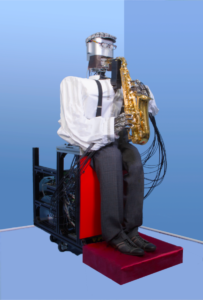English follows Japanese
『舞台に立つロボットたち:芸術と工学の交差点における技術の過去・現在・未来』林家宇
発表要旨
本発表では、舞台芸術におけるロボット技術の歴史的展開と将来的可能性について概観する。「ロボット」という言葉が初めて用いられたのは、1920年の小説家カレル・チャペックが発表した戯曲『R.U.R.(ロッサム万能ロボット商会)』においてであり、当初から人間に似た存在が労働や芸術の領域に介入する可能性が想定されていた。
ロボットの起源はさらに古く、古代ギリシャの自動機械や、日本の江戸時代に見られるからくり人形にまでさかのぼる。これらの装置は、人々に驚きや感動を与えると同時に、機械による芸術表現の萌芽として重要な位置を占めてきた。20世紀のヨーロッパでは自動演奏人形や舞台装置が登場し、日本でも能や歌舞伎における仕掛け舞台など、芸術と技術の融合が進んだ。これらは、現代における舞台ロボットの基盤として再評価されつつある。
近年では、楽器演奏ロボットの研究が進展し、人間の感性や表現力を再現・拡張する技術が注目を集めている。特に、本学総合機械工学科・高西研究室において開発されている一連の音楽ロボット群は、人間と同等な演奏能力を持ち、その成果は国内外で高く評価されている。発表者自身も、同研究室にてヒューマノイド型サキソフォンロボットや指揮者ロボットの開発に取り組んでおり、人間の身体運動や音楽的意図の再現に挑戦している。
将来的には、舞台芸術におけるロボットは、単なる機械的な演者にとどまらず、AIやセンシング技術と融合し、人間と共に舞台を創り上げる「創作パートナー」としての役割を果たすことが期待される。本発表では、芸術とロボット工学の交差点に立ち、舞台表現の新たな可能性と課題について多角的に論じる。

開催概要
- 日 時:2025年7月12日(土)16:30-18:00
- 場 所:早稲田大学早稲田キャンパス3号館406教室 およびZoom配信
- 発表者:林家宇(早稲田大学)
- 司会者:石井道子(早稲田大学)
- 言 語:日本語
- 主 催:早稲田大学総合研究機構 オペラ/音楽劇研究所
参加申込方法
Zoom参加者は事前登録が必要です。参加希望者はできるだけ前日の7月11日(金)までに以下のURLから事前登録をしてください。
URL: https://list-waseda-jp.zoom.us/meeting/register/jG_tqZvGTsa7iiqgHGDuHg
※Zoom自動登録制なので、主催者側からはズーム招待状をお送りしません。(なお飛び入り参加も可能です。)
※ご出席の際フルネームの表示をお願いします。発言時以外はミュートおよびビデオ・オフにしてください。スクリーンショット撮影、録音、録画等は厳にお控え願います。また司会者の指示にしたがってください
問合せ先
早稲田大学総合研究機構オペラ/音楽劇研究所:https://prj-opera-mt.w.waseda.jp/
e-mail address: operaken-uketsuke[at]list.waseda.jp ([at] = @)
(この例会案内は後ほど Facebookと X(旧Twitter)でも発信されますので、そちらでも見ることができます。)
発表者プロフィール
林家宇(Jia-Yeu Lin)
ロボティクス研究者、舞台芸術と工学の融合に取り組む実践的研究者。早稲田大学理工学術院国際理工学センター講師。専門はヒューマノイドロボット、ヒューマン・ロボット・インタラクション(HRI)、音楽演奏ロボットの開発と制御。特に人間の身体運動と音楽表現の再現を通じた芸術支援ロボットの設計に注力している。
主なプロジェクトに、サキソフォン演奏ロボット「Waseda Saxophonist Robot」、指揮者ロボット「Waseda Conductor Robot」の開発がある。近年では国際会議や学術誌での発表に加え、ロボットによる舞台芸術表現の可能性についても発信している。
Monthly Regular Meeting, July 2025 (230th Meeting of the Opera Research Group)
Robots on Stage: The Past, Present, and Future of Technology at the Crossroads of Art and Engineering: Jia-Yeu LIN
Abstracts
This presentation offers an overview of the historical development and future potential of robotic technologies in the performing arts. The term “robot” was first introduced in the 1920 play R.U.R. (Rossum’s Universal Robots) by Czech writer Karel Čapek, where the possibility of human-like beings intervening in labor and artistic domains was envisioned from the outset.
The origins of robotics, however, date back much earlier—to the automata of ancient Greece and Japan’s Edo-period karakuri dolls. These devices not only astonished and moved audiences but also served as important precursors to mechanical expressions of art. In the 20th century, Europe saw the rise of automatic musical dolls and stage mechanisms, while in Japan, technical innovations in Noh and Kabuki theatre fostered a fusion of artistry and engineering. These historical examples are now being reevaluated as the foundation for contemporary stage robots.
In recent years, the development of musical performance robots has advanced significantly, drawing attention to technologies that replicate or even extend human sensitivity and expressiveness. Of particular note is the series of musical robots developed at the Takanishi Laboratory, Department of Modern Mechanical Engineering, Waseda University. These robots possess performance capabilities comparable to those of human musicians and have been recognized both domestically and internationally. The presenter has been engaged in the development of humanoid saxophone-playing robots and conductor robots at the same laboratory, aiming to recreate the physical motion and musical intent of human performers.
Looking ahead, robots in the performing arts are expected to evolve beyond the role of mechanical performers. By integrating with AI and sensing technologies, they are poised to become “creative partners” who co-create stage productions alongside humans. This presentation explores the new possibilities and challenges of stage expression from a multidisciplinary perspective, situated at the intersection of art and robotics.

Event Outline
- Time and Date: July 12th (Sat.) 2025, 16:30 – 18:00 (JST)
- Format: HyFlex (On-Campus and Online meeting (Zoom))
- Venue: Waseda University, Waseda Campus, Room 406 of Building 3
- Presenter: Jia-Yeu LIN
- Affiliation: Faculty of Science and Engineering, Global Center for Science and Engineering
- Moderator: Michiko ISHII
- Language: Japanese
- Organized by: Waseda Institute for Research in Opera and Music Theatre (WIROM), Comprehensive Research Organization, Waseda University
Registration
Registration is required by July 11th (Fri.) for online participants.
Please register through the following URL:
https://list-waseda-jp.zoom.us/meeting/register/jG_tqZvGTsa7iiqgHGDuHg
*Please show your full name on the display, mute yourself, and turn off the video, except when talking; refrain from taking screenshots, recordings, etc., and follow the moderator’s instructions.
Contact
Waseda Institute for Research in Opera and Music Theatre (WIROM), Comprehensive Research Organization, Waseda University: https://prj-opera-mt.w.waseda.jp/
e-mail address: operaken-uketsuke[at]list.waseda.jp ([at] = @)
(This information will be sent later by Facebook and X (Twitter). You can see it there, too.)
Profile of Presenter
Jia-Yeu LIN
Robotics researcher and practical scholar working at the intersection of performing arts and engineering. Lecturer at the Global Center for Science and Engineering, Waseda University.Her areas of expertiseinclude humanoid robots, human-robot interaction (HRI), and the development and control of musical performance robots. Her research particularly focuses on designing art-assistive robots capable of replicating human body movements and musical expression.
Her major projects include the development of the Waseda Anthropomorphic Saxophonist Robot and Waseda Conductor Robot. In recent years, she has presented her work at international conferences and in academic journals, while also exploring the expressive potential of robots in the performing arts.